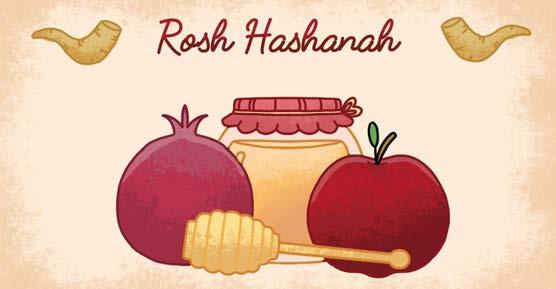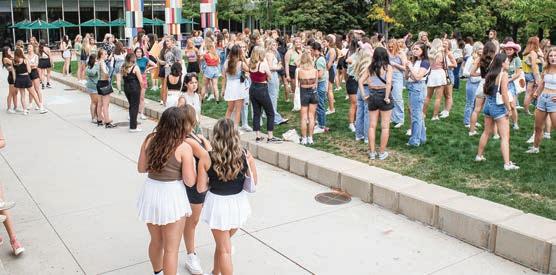
12 minute read
dinner
RELIGION
A ‘sweet new year’: Chabad at CSU hosts Rosh Hashanah dinner
By DJ Vicente
@deejmako
On Sept. 25, in a sunset-lit room within the Fort Collins Senior Center, Rabbi Yerachmiel Gorelik gave a speech to his congregation to commence Sunday evening’s service preceding this year’s Rosh Hashanah dinner.
“It’s a lot more than a new year’s celebration,” Gorelik said. “Every year, the world gets recreated. ... It’s a day where you get literally recreated.”
Gorelik, who serves as faculty advisor for the Colorado State University Chabad Jewish Student Organization, explained the importance of Rosh Hashanah to Jewish people, describing the holiday as more than a celebration of the Jewish new year.
“It’s about a new beginning in the sense that, you know, we are thoughtful and reflect and meditate on our past year and find the areas that we can improve in and make real resolutions, … resolving to make a better version of ourselves,” Gorelik said.
The Chabad of Northern Colorado website describes the religious significance of Rosh Hashanah as “the birthday of the universe, the day G-d created Adam and Eve, and it’s celebrated as the head of the Jewish year.”
“Just like the head allocates everything to the rest of the body, so too does Rosh Hashanah,” Gorelik said.
The website also explains the timeline of Rosh Hashanah. It’s split between the first two days of the Jewish new year, Tishrei 1 and Tishrei 2, with this year’s Rosh Hashanah beginning at sundown Sept. 25, the eve of Tishrei 1, and continuing through nightfall Sept. 27.
The evening transitioned into the dinner of Rosh Hashanah, beginning with reciting kiddush over cups of wine (though this event used grape juice in place of wine, as children were present) and the dipping of apples and challah loaves into honey.
Sarah Daniel, member of the Sigma Alpha Epsilon Pi sorority, a sorority specializing in Jewish interest, explained the apples, challah loaves and honey as symbols for a “sweet new year.”
Chaia Geltser, president of Chabad at CSU, mentioned Chabad of Northern Colorado’s connection to both the Jewish community within CSU and the Jewish communities outside of campus as well, connecting with members primarily from the Fort Collins area.
“In Fort Collins, the rabbi has done a really good job of involving the Jewish community outside of CSU,” Geltser said. “And so we kind of come together a lot and celebrate a lot, and it’s quite an interesting and diverse mix of people, but it makes for a really fun and interesting time, and you make connections with people you might otherwise not have met.”
Geltser also mentioned Chabad of Northern Colorado’s and Gorelik’s work in “creating a strong, educational aspect of Chabad,” serving to educate both Jewish and non-Jewish students in religious and cultural traditions such as Rosh Hashanah.
“The majority of people there are Jewish, but it’s really fun to have nonJewish members there who are just genuinely interested in learning about it and seeing what goes on because that’s just how we come together as a people,” Geltser said.
Members of Chabad explained the importance of this year’s Rosh Hashanah due to the previous two years of COVID-19 restrictions placing barriers on large gatherings, adversely affecting important Jewish observances.
“I think it’s important because, you know, we’re all able to come together again and celebrate together in the Jewish new year and new beginnings, and we’re all able to celebrate that together after COVID-19,” said Macy Palbaum, officer for Chabad at CSU.
Gorelik mentioned how appropriate this year’s Rosh Hashanah is coming out of the pandemic.
“We’ve all been very tested (and) gone through hard times, but you know, once again, that irrepressible strength of the human spirit is what we celebrate too,” Gorelik said. “With joy and effort and love, we will always prevail.”
Reach DJ Vicente at life@ collegian.com.
GRAPHIC ILLUSTRATION BY TRIN BONNER THE COLLEGIAN
CULTURE
CSU students take on rejection post-rush week
Students at Colorado State University participate in bid day at the Lory Student Center West Sculpture Garden Sept. 20. Bid day is part of the formal rush experience. Those who went through the recruitment process met on bid day, where it was revealed which Greek life organization they were accepted into. PHOTO BY CAT BLOUCH THE COLLEGIAN
By Katherine Borsting
@katbor2025
The rise of #RushTok and Alabama rush content on social media has shown sorority rush week as a glamorous, multi-day process that can make or break a woman’s college experience.
Colorado State University held their recruitment Sept. 1720. Many women on campus attended the events in hopes of finding a group they would fit best with.
Compared to other schools around the country, CSU has a much simpler process. On the first day, each person attends every sorority, and they can return to up to five sororities the following day. As day three comes, they are only allowed to return to two sorority houses.
Not everyone is given their top choice on the third day; some may get called back to houses they did not enjoy, and some don’t get called back at all.
First-year Ingrid Dierkhising participated in recruitment this year and hoped to meet new friends and find a sense of home on such a big campus. She was not given a bid, although she was able to find some good in the process.
“I’m glad I did it,” Dierkhising said. “It was interesting to go through, and I met a lot of people.”
She went on to say how sometimes conversations felt forced and there are a lot of do’s and don’ts on what can be said. It is encouraged to avoid discussing partying, relationships and other related things.
“I feel like you have to be on your A-game all the time,” Dierkhising said.
Initially, she was disappointed she did not receive a bid but is now happy she does not have to follow the rules that come along with it.
“My biggest takeaway is you don’t need to be in a sorority to make a lot of friends,” Dierkhising said.
Many people hold the recruitment process to a high standard and anticipate being a part of their top choice during the experience. The CSU Panhellenic Association tries to stay away from a “top house” narrative.
Gilli Ryan was a recruitment coach during this fall’s recruitment and explained how the Panhellenic Association really tries to push the idea all the sororities are one large community.
“Recruitment is value-based here, and we try to let the girls know whatever house they end up in would be great,” Ryan said.
She went on to explain she thinks it is important to go through the process because it allows them to find a smaller circle in such a large school and meet people similar to them.
Many people do not end up staying in a sorority once given a bid. The term for leaving is “dropping” and can be done anytime while active in a sorority.
The process of recruitment is marketed as finding a “home;” however, some people are not able to click with a group, resulting in the decision to drop.
“I ended up leaving my sorority because I did not find what I was looking for,” CSU junior Isabelle O’Neill said. “I ended up meeting wonderful people outside of my sorority and did not have the friendships I thought I would get from being in a sorority.”
She went on to say how she just was not as passionate about the Greek life lifestyle as others were.
When asked if she regretted the decision, O’Neill said in the beginning, she had doubts, but as time went on, she was more sure of her decision.
Enjoyment of sorority life depends on the individual. There are many different outcomes of participating in recruitment, and there is no evidence that being in a sorority will be a deciding factor in the amount of fun someone has in college.
Reach Katherine Borsting at life@ collegian.com.
INGRID DIERKHISING
FIRST-YEAR RUSH PARTICIPANT

NUGS OF WISDOM
Guidelines for lower-risk cannabis use
By Grayson Acri
@guy1376
Cannabis is often marketed and presented as a less problematic drug than its contemporaries, alcohol and tobacco. However, just like everything else in this world, there is a risk associated with cannabis use.
Lucky for you, dear reader, there are ways to mitigate this risk while still partaking.
In a new review of previous studies published in the International Journal of Drug Policy, scientists created general guidelines for lower-risk cannabis use.
The article contains 12 recommendations, but there are a few major, actionable guidelines: Delay cannabis use until adulthood, avoid high-potency THC products, use infrequently, abstain from inhalation methods and refrain from driving high.
First is waiting until adulthood. Luckily, you have confirmed you’re at least 21 to enter this section, so you’re at much lower risk than adolescents for cannabis use. Cannabis use prior to the completion of puberty is associated with “adverse health and psycho-social effects, especially in those who engage in intensive use,” according to the study.
The primary concern for younger users is developing a cannabis use disorder or addiction, as the brain is still growing.
“In general, the later in young adult life cannabis use is initiated, the lower the risks of adverse effects on general health and well-being,” according to the study. This recommendation is reasonably obvious and is part of why the legal age for cannabis use is 21.
The second key recommendation is to use low-potency cannabis products. The National Institute on Drug Abuse states the THC potency of cannabis products seized by the Drug Enforcement Administration has substantially increased from almost 4% in 1995 to nearly 15% in 2019, with the CBD content generally decreasing.
While this is a study of illegal products, the general potency of products in the legal market is higher. Extracts and vapes often get close to 80-90% THC, and flower products can be found with THC contents well over 20% — nearly four to five times more potent than in the mid-90s.
“The higher the total or relative THC content of cannabis that is used, the greater the risks of acute and chronic adverse mental or physical health outcomes,” the study states. It also notes CBD can moderate some of the adverse effects of THC, but it is not a silver bullet and does not fix THC’s negative outcomes.
The third and fourth recommendations have to do with how you’re using cannabis. Smoking is one of the most common methods of cannabis use and comes with plenty of carcinogens and toxins. Vaping appears to have less problematic exposure but is not without problems of its own. Edibles are a feasible alternative, but the study still recommends caution about overconsumption.
The fifth recommendation the study highlights is reasonable usage. Frequent (daily/near daily) use and intensive (binge) use are “strongly associated with a multiplicity of severe adverse outcomes in mental and physical health (e.g., including neurocognitive deficits and dependence) and psycho-social domains.”
The general advice here is to know what you’re using and how often you’re using it. If you choose to use higher potency products frequently, try to use less in a single session and stick to using once or twice a week.
Finally, the review emphasizes that you shouldn’t drive while high. When impaired in this way, risk of death in a motor vehicle increases substantially.
“Overall, there is no categorically ‘safe’ route of use for cannabis, and each route option brings some level of distinct risks that needs to be taken into account for use,” according to the study.
As with everything in this world, cannabis use is not without risks, but there are more responsible ways to partake. In general, waiting until adulthood, taking a reasonable dosage, keeping usage in check, choosing lower-risk consumption methods and avoiding high-risk behaviors such as driving are all good ways to stay safe while remaining lifted.
Reach Grayson Acri at cannabis@ collegian.com.
BECAUSE I GOT HIGH
On repeat and too many dabs

By Guest Authors

@csucollegian
Editor’s Note: “Because I Got High” content consists of community story submissions and does not represent the views of The Collegian or its editorial board. The Collegian does not promote underage or excessive substance use or impairment for the purpose of creating a submission. On repeat
One time I got really stoned and listened to “Invincible” by Omar Apollo on repeat for like three hours. Absolutely mesmerizing. Too many dabs
The first time I ever tried wax, I decided to show off in front of my

GRAPHIC ILLUSTRATION BY BRIAN PEÑA
THE COLLEGIAN
friends and took four dabs. I soon realized that was a mistake. As I walked around the house, I had visions of exactly how every object I touched was made. It was very similar to the meme of math equations flying around a confused man’s head. Regardless, I felt I was the smartest person in the room and had to let my friends know. I started singing the Bill Nye introduction song while dancing around, flipping off my friends since I unlocked a new level of intelligence. My friends were pretty sick of me by the end of the night, so I didn’t touch wax for a while after that.
To submit stories, email cannabis@ collegian.com or fill out our Google Form, which is linked alongside guidelines in our Letter from the Editor.

GRAPHIC ILLUSTRATION BY TRIN BONNER THE COLLEGIAN
18+ MEDICAL
I T ’S SIMPLE
BEST MEDS, BEST PRICES, BEST SERVICE
$54.99 ounces! $5 1 gram pre-rolls
MUNCHIEMONDAY - 20% OFF ALL EDIBLES
CART TUESDAY - $5 OFF 1 GRAM CARTS / $2.50 OFF 1/2 GRAM CARTS. *** select carts and strains TOP SHELFTHURSDAY - 10% OFF ALL TOP SHELF AND PLATINUM SHELF FLOWER
SHAKE OUNCESUNDAY - $25 SHAKE OUNCES WHILE SUPPLIES LAST!
WAXWEDNESDAY - 8 GRAMS FOR $64. KUSH MASTERS SELECT STRAINS. TIER 1 8 GRAMS FOR $80, TIER 2 8 GRAMS FOR $125, TIER 3 8 GRAMS FOR $142.48.
ENJOY R E S P O N S I B LY
WWW.FLOWERPOWERBOTANICALS.COM 970-672-8165 1308 DUFF DR., FORT COLLINS, CO 80524




